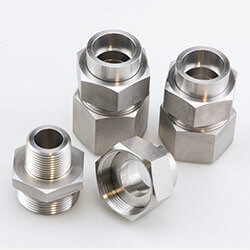Product Torque Values
Product torque values help you understand how to operate various CPV products. Specific charts give you the exact minimum and maximum that should be used while also giving you directions.
Learn more in the charts below.
 Torque Values for Bonnets, Gland Nuts, and Stem Retainers of O-Seal Hand Valves: This chart describes what torque values should be used to assemble the valves. The values listed are for dry assembly, but if lubrication is used on the threads, torques that are closer to the minimum should be used.
Torque Values for Bonnets, Gland Nuts, and Stem Retainers of O-Seal Hand Valves: This chart describes what torque values should be used to assemble the valves. The values listed are for dry assembly, but if lubrication is used on the threads, torques that are closer to the minimum should be used.
The chart also details the minimum values’ limit for permanent assembly. Torque values below the minimum or larger than the maximum shouldn’t be used.
Operating Torque Values for O-Seal and G-Series Hand Valves: This table represents the maximum torques that can be encountered. Typically, the operating torques are 10% to 20% less than the figures represented. This depends on the fluid in the valve, the stem lubrication, and the seat condition. Learn more about operating pressures.
Torque Values for Bonnets and Gland Nuts of G-Series Valves: This table displays the torque values that should be used to assemble the given valves. The valves listed are to be used for dry assembly. In the case that lubrication is used, the torques used should be closer to the minimum. The minimum values listed establish the lower limit for permanent assembly.
 Union Nut Torque Values for O-Seal Cat. 50N: This chart shows the torque values that should be used for tightening CPV O-Seal Union Nuts when creating a joint. The values listed in this chart apply to joints that are installed into a piping system and don’t apply for stock assembly or shipping assembly.
Union Nut Torque Values for O-Seal Cat. 50N: This chart shows the torque values that should be used for tightening CPV O-Seal Union Nuts when creating a joint. The values listed in this chart apply to joints that are installed into a piping system and don’t apply for stock assembly or shipping assembly.
The minimum values are the lower limits for permanently made-up joints, and the values below the minimum may be used for temporary service. Values larger than the maximum aren’t recommended.
Straight Thread Torque Values for Various CPV Fittings: This chart displays torque values that should be used for tightening straight thread O-Ring sealed threaded connections. The values apply to steel and/or stainless steel components.
Union Nut Torque Values for Mark VIII Cat. H850N: Adhere to the torque values on this chart when tightening CPV Mark VIII Union Nuts and making up a joint. The values apply to joints installed into a piping system and aren’t for stock assembly or shipping assembly.
Torque Values for Bonnets of Mark VIII Shutoff and Regulating Valves: This chart represents the torque values to be used for assembling the listed valves. They’re only to be used for dry assembly. If lubrication is used on the threads, it’s recommended that torques closer to the minimum be used.
Operating Torque Values for Seating of Mark VIII Shutoff and Regulating Valves: This table shows the maximum torques that may be encountered. On average, the actual operating torques are 10% to 20% less than the figures listed, depending on several factors.

